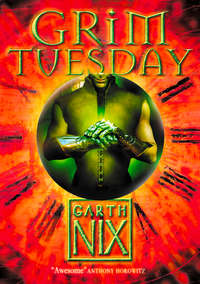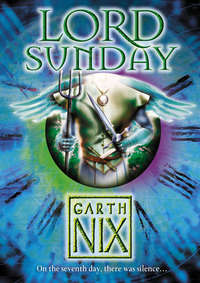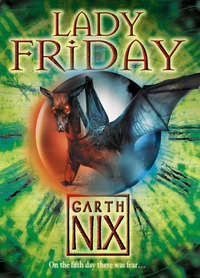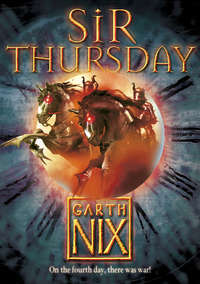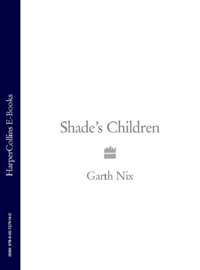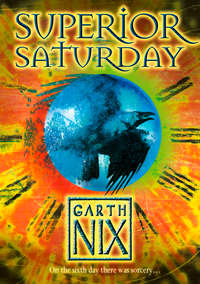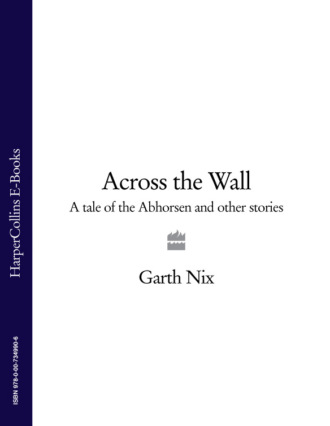
Полная версия
Across The Wall: A Tale of the Abhorsen and Other Stories

ACROSS THE WALL
A Tale of the Abhorsen and Other Stories
GARTH
NIX
Illustrated by David Wyatt

Copyright
Across the Wall: A Tale of the Abhorsen and Other Stories First published in hardback in the USA by HarperCollins Publishers 2005 First published in hardback in Great Britain by HarperCollins Publishers Ltd 2006 HarperCollins Children’s Books is an imprint of HarperCollins Publishers Ltd 77-85 Fulham Palace Road, Hammersmith, London, W6 8JB
Published by HarperCollins Children’s Books a division of HarperCollinsPublishers Ltd, 77–85 Fulham Palace Road, Hammersmith, London W6 8JB www.harpercollins.co.uk www.garthnix.co.uk
“Nicholas Sayre and the Creature in the Case”: Copyright © 2005 by Garth Nix. First published as The Creature in the Case for World Book Day 2005 by HarperCollins Publishers, UK.
“Under the Lake”: Copyright © 2001 by Garth Nix. First published in The Magazine of Fantasy & Science Fiction (USA), February 2001, USA.
“Charlie Rabbit”: Copyright © 2005 by Garth Nix. First published in Kids’ Night In, collected for War Child, HarperCollins Publishers, UK and Australia.
“From the Lighthouse”: Copyright © 1996 by Garth Nix. Published in Fantastic Worlds, edited by Paul Collins, HarperCollins Publishers, Australia, 1998.
“The Hill”: Copyright © 2001 by Garth Nix. First published in X-Changes: Stories for a New Century, Allen & Unwin, Australia. “Lightning Bringer”: Copyright © 2001 by Garth Nix. First published in Love & Sex, edited by Michael Cart, Simon & Schuster, USA, and on Salon.com.
“Down to the Scum Quarter”: Copyright © 1987 by Garth Nix. First published in the magazines Myths and Legends (1987) and Breakout! (1988).
“Heart’s Desire”: Copyright © 2002 by Garth Nix. First published in The Road to Camelot, edited by Sophie Masson, Random House, Australia, and The Magazine of Fantasy & Science Fiction, January 2004, USA.
“Hansel’s Eyes”: Copyright © 2000 by Garth Nix. First published in A Wolf at the Door, edited by Ellen Datlow and Terri Windling, Simon & Schuster, 2000, USA.
“Hope Chest”: Copyright © 2003 by Garth Nix. First published in Firebirds, edited by Sharyn November, Penguin 2003, USA. “My New Really Epic Fantasy Series”: Copyright © 1999 by Garth Nix.
“Three Roses”: Copyright © 2000 by Garth Nix. First published in Eidolon, Autumn 2000, Australia.
“Endings”: Copyright © 2004 by Garth Nix. First published in Gothic! Ten Original Dark Tales, edited by Deborah Noyes, Candlewick Press, USA.
ACROSS THE WALL copyright © Garth Nix 2005, 2006
Garth Nix asserts the moral right to be identified as the author of the work.
All rights reserved under International and Pan-American Copyright Conventions. By payment of the required fees, you have been granted the non-exclusive, non-transferable right to access and read the text of this e-book on-screen. No part of this text may be reproduced, transmitted, down-loaded, decompiled, reverse engineered, or stored in or introduced into any information storage and retrieval system, in any form or by any means, whether electronic or mechanical, now known or hereinafter invented, without the express written permission of HarperCollins e-books.
HarperCollinsPublishers has made every reasonable effort to ensure that any picture content and written content in this ebook has been included or removed in accordance with the contractual and technological constraints in operation at the time of publication.
Source ISBN: 9780007221462
Ebook Edition © SEPTEMBER 2009 ISBN: 9780007349906
Version 2014-12-08
To Anna, Thomas and Edward and all my family and friends
preface
Four years ago, after a Christmas lunch, my younger brother passed around a very small “book” of four stapled-together pages that he said he’d found while helping my mother clean out a storage area under the family home. The book contained four stories written in shaky capital letters, with a couple of half-hearted illustrations done with coloured pencils. On the front, it had “Stories” and “Garth Nix” in the handwriting one would expect from someone aged around six.
The stories included such gems as “The Coin Shower” which was very short and went something like:
a boy went outside it started raining coins he picked them up
I had no memory of this story or the little booklet and at first I thought it had been fabricated by my brother as a joke, but my parents remembered me writing the stories and engaging in this bit of self-publishing at an early age.
I wrote “The Coin Shower” and the other stories in that collection about thirty-five years ago and I’ve been writing ever since. Not always fiction, though. In my varied writing career I’ve written all kinds of things, from speeches for CEOs to brochures about brickworks to briefing papers on new Internet technologies.
I first got into print writing articles and scenarios for the role-playing games Dungeons and Dragons and Traveller when I was sixteen or seventeen. I wrote for magazines like Multiverse and Breakout! in Australia and White Dwarf in the United Kingdom. I tried to crack Dragon magazine in the United States, but never quite managed to sell them anything.
This minor success in getting role-playing game articles or scenarios into print led me to try my hand at getting some of my fiction published. I’d written quite a few stories here and there without success, but when I was nineteen years old I wrote a whole lot more while I was travelling around the UK and Europe, broadening my horizons. I drove all over the place in a beat-up Austin 1600 with a small metal Silver-Reed typewriter in the back seat, a couple of notebooks and lots of other people’s books. Every day I’d write something in longhand in my notebook, and then that night or perhaps the next morning I’d type up what I’d written. (That established a writing practice that has continued for more than twenty years: I write most of my novels in longhand, typing up each chapter on the computer after I’ve got the first draft done in the latest black-and-red notebook. I now have more than twenty of these notebooks, plus one very out-of-place blue-and-white-striped notebook that I turned to during the stationery drought of 1996.)
I don’t write everything in longhand first, though; sometimes I just take to the keyboard. Most of my short fiction begins with handwritten notes and perhaps a few key sentences put down with my trusty Waterman fountain pen, but then I start typing. The pen comes into its own again later, when I print out the story, make my changes and corrections, and then go back to the computer. This process often occurs when I have only part of the story written. I quite often revise the first third or some small part of a story six or seven times before I’ve written the rest of it. Often the revision occurs because I have left the story incomplete for a long time and I need to revisit the existing part in order to feel my way into the story again.
Both my short and long fiction works usually begin with a thinly sketched scene, character, situation or some combination of all three, which just appears in my head. For example, I might suddenly visualise a huge old mill by a broad river, the wheel slowly turning, with the sound of the grinding stones underlaid by the burble of the river. Or I might think of a character, say a middle-aged man who has turned away from the sorcery of his youth because he is afraid of it, but who will be forced to embrace it again. Or a situation might emerge from my subconscious, in which a man, or something that was once a man, is looking down on a group of travellers from a rocky perch, wondering whether he/it should rob them.
All these beginnings might come together into the story of a miller, once a sorcerer, who is transformed into a creature as the result of a magical compact he thought he had evaded. So he must leave his settled life and become a brigand, in the hope of finding, on one of the magicians or priests he robs on the road, the one item of magical apparatus that can return his human shape.
Or they might not come together. I have numerous notes for stories, and many partly begun stories, that have progressed no further. Some of these fragments might be used in my novels, or at least be the seeds of some elements in one. A few ideas will progress and grow and become stories, complete in themselves. The great majority of my jotted-down ideas, images and scraps of writing will never become anything more than a few lines in a black-and-red notebook.
The stories in this collection are the ones that got past the notes stage, that became a few paragraphs, then a few pages, and somehow charged on downhill to become complete. They represent a kind of core sample taken through more than fifteen years of writing, from the callow author of twenty-five who wrote “Down to the Scum Quarter” to the possibly more polished forty-one-year-old writer of “Nicholas Sayre and the Creature in the Case”.
Fortunately, you have been spared some even earlier efforts, including the heavily T H White-influenced short story I published in my school magazine at fifteen, and even my very first professional short story sale, which felt like a great triumph for me at nineteen years old but now looks rather out of place with my later works.
I hope you find some stories here that you will enjoy, or wonder about, or that linger uncomfortably in the mind when you wish they didn’t. But if your favourite story is “The Coin Shower”, please do not write and tell me that my writing has been going downhill ever since I was six.
GARTH NIX
December 1, 2004
Sydney, Australia
Table of Contents
Cover Page
Title Page
Copyright
Dedication
preface
introduction to Nicholas Sayre and the Creature in the Case
Nicholas Sayre and the Creature in the Case
introduction to Under the Lake
Under the Lake
introduction to Charlie Rabbit
Charlie Rabbit
introduction to From the Lighthouse
From the Lighthouse
introduction to The Hill
The Hill
introduction to Lightning Bringer
Lightning Bringer
introduction to Down to the Scum Quarter
Down to the Scum Quarter A Fantasy Solo Adventure
introduction to Heart’s Desire
Heart’s Desire
introduction to Hansel’s Eyes
Hansel’s Eyes
introduction to Hope Chest
Hope Chest
introduction to My New Really Epic Fantasy Series
My New Really Epic Fantasy Series
introduction to Three Roses
Three Roses
introduction to Endings
Endings
Keep Reading
Frequently Asked Questions
introduction to The Prologue that Never Was
Prologue
Also by Garth Nix
About the Publisher
introduction to Nicholas Sayre and the Creature in the Case
Ihave explored Ancelstierre and the Old Kingdom a little in my novels Sabriel, Lirael and Abhorsen, and in the process I have found out (for that’s often what it feels like, even though I’m the one making it up) quite a lot about these lands, the people and creatures that inhabit them, and their stories.
But there is much, much more that I don’t know about, and will never know about unless I need it for a story. Unlike many fantasy writers, I don’t spend a lot of time working out and recording tons of background detail about the worlds that I make up. What I do is write the story, pausing every now and then to puzzle out the details or information that I need to know to make the story work. Some of that background material will end up in the story, though it might be veiled, mysterious or tangential. Much more will sit in my head or roughly jotted down in my notebooks, until I need it next time or until I connect it with something else.
Every time I re-enter the world of the Old Kingdom and Ancelstierre, I find myself stitching together leftover bits and pieces that I already knew about, as well as inventing some more that seem to go with what is already there.
“Nicholas Sayre and the Creature in the Case” was particularly interesting for me to write, because in it I connect various bits and pieces of information about Ancelstierre, rather than the Old Kingdom. As always, the story is the most important thing to me, but this novella also gives a glimpse of the people, customs, government, technology and landscape of Ancelstierre.
Like nearly everything I write, this is a fantasy adventure story, this time with a dash of country-house mystery, a twist of 1920s-style espionage and a humorous little umbrella on the side that may be safely ignored by those who don’t like it (or don’t get it). Some readers may detect the influence of some of the authors outside the fantasy genre (as it is usually defined today) whom I admire, including Dorothy Sayers and P G Wodehouse.
Planned to be a longish short story, “Nicholas Sayre and the Creature in the Case” grew and grew till it became a novella and ended up taking many more months to write than I had anticipated. It started with these notes:
Nicholas and Uncle to country house Full of debs and stupid young men Thing in the Case, eyes follow Nick Autumn haymaking thing gets some of Nick’s blood? refuge in river, thing closes sluice hay fires in a circle it is powerful, but poisoned how far are we from the Wall?
That was the kernel, from which a novella grew over about ten months. I don’t know why I wrote it rather than something else. It wasn’t sold to a publisher, I didn’t have a deadline for it and I had plenty of other things to do. But only a week or so after writing those notes, I sat down and wrote the first three or four pages in one sitting. I kept coming back to it thereafter, caught up (as I often am as both writer and reader) simply by the desire to see what happened next.
Конец ознакомительного фрагмента.
Текст предоставлен ООО «ЛитРес».
Прочитайте эту книгу целиком, купив полную легальную версию на ЛитРес.
Безопасно оплатить книгу можно банковской картой Visa, MasterCard, Maestro, со счета мобильного телефона, с платежного терминала, в салоне МТС или Связной, через PayPal, WebMoney, Яндекс.Деньги, QIWI Кошелек, бонусными картами или другим удобным Вам способом.


